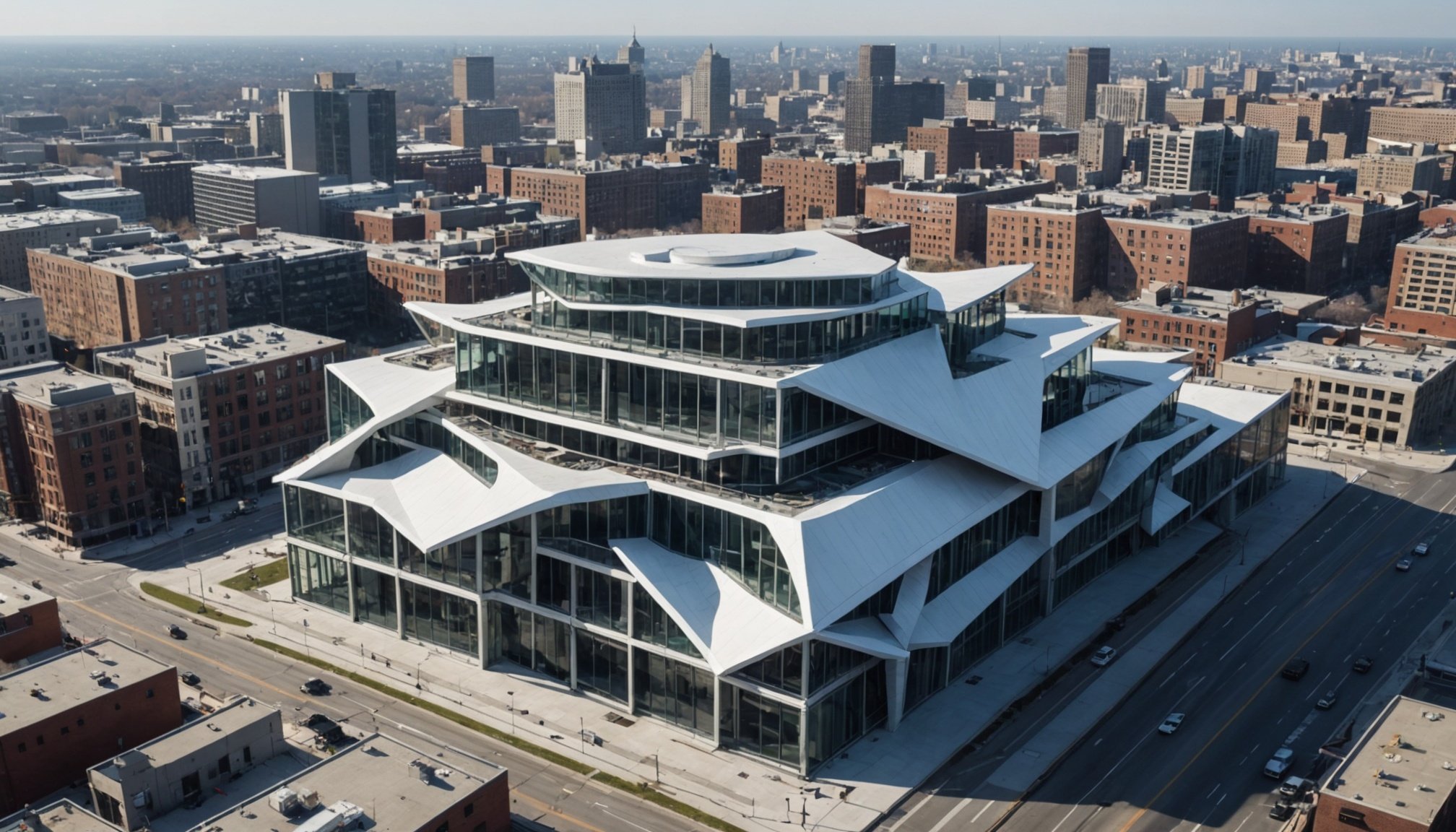Introduction to Computational Fluid Dynamics in Architecture
Computational fluid dynamics (CFD) is revolutionising the field of architecture by harnessing the power of simulation to influence modern design. In the sphere of architectural practice, CFD denotes the use of algorithmic precision to assess airflow and fluid interactions around structures. This approach is crucial in creating sustainable and wind-resistant buildings.
The significance of CFD lies in its ability to transform complex fluid interactions into visual simulations. Architects utilise these data points to foresee potential design drawbacks, ensuring their projects stand resilient against climatic factors like wind. As buildings become increasingly complex, CFD aids in predicting how edifices will perform under environmental stressors, thus ensuring structural integrity remains uncompromised.
Also to discover : Transform your social media strategy using an ai content creator
Over the years, CFD technology has evolved tremendously. Earlier used primarily in industrial applications, its integration into architectural design has become commonplace. By addressing issues such as wind resistance, architects are able to craft innovative solutions that enhance the durability of their constructions.
In essence, adopting CFD within architectural practices provides a foresight that extensively enriches design processes, fostering the optimisation and advancement of building resilience. This interest aligns with modern-day requirements for creating safe, energy-efficient urban landscapes that can withstand diverse weather patterns.
Also read : Transforming air quality assessment: how electrochemical sensors are shaping the future
CFD Methodologies for Enhancing Wind Resistance
In modern architectural practice, employing CFD methodologies is crucial for enhancing a building’s wind resistance and ensuring structural integrity. These methodologies include various simulation techniques that predict airflow patterns and pressures around a building design, allowing architects to optimise designs before construction begins.
Key techniques such as computational fluid dynamics simulations are integrated into the early design phase to provide predictive analysis that traditional methods simply cannot match. For example, CFD allows architects to refine shapes and materials to mitigate adverse wind effects, thus enhancing resilience.
Comparing traditional methods with CFD-enhanced approaches, the latter offer clear advantages. Traditional wind tunnel testing can be costly and time-consuming, offering limited scenarios. In contrast, CFD allows for virtual experiments under diverse conditions, providing more comprehensive insights. Additionally, CFD offers a more cost-effective and detailed analysis, accommodating changes swiftly and effectively.
By integrating CFD into architectural design, projects benefit from a sophisticated understanding of how a structure interacts with its environment. This pre-emptive assessment is invaluable, ensuring the final structure stands firm against the elements, reducing potential risks and costs associated with design flaws. Embracing these CFD methodologies is thus indispensable for architects aiming to lead in resilient and innovative design.
Case Studies and Real-World Applications
In the realm of architecture, the application of computational fluid dynamics (CFD) has been transformative across various building types, including high-rise buildings, low-rise structures, and urban planning innovations.
High-Rise Buildings
In skyscraper design, CFD applications offer critical insights into wind resistance improvements. For instance, the Burj Khalifa’s design process utilized extensive CFD simulations to mitigate wind load impacts. These simulations allowed engineers to adjust the building’s tapering form, ensuring stability without compromising on aesthetics.
Low-Rise Structures
Low-rise structures benefit equally from CFD analysis, particularly in optimizing natural ventilation. A notable case is the Genzyme Center, where CFD was employed to refine atrium designs, enhancing passive cooling and reducing reliance on air conditioning.
Urban Planning Innovations
CFD aids urban planners in addressing environmental challenges within cityscapes. In Singapore’s BCA SkyLab project, CFD simulations predicted airflow patterns, contributing to city planning innovations that promote sustainable building practices.
These case studies demonstrate the practical benefits of integrating CFD in architectural design, providing valuable lessons and scalable techniques that enhance aerodynamic performance and energy efficiency across a spectrum of architectural projects.
Benefits of Implementing CFD in Building Designs
Incorporating computational fluid dynamics (CFD) in modern building design offers a multitude of advantages, significantly enhancing wind resistance and aerodynamic properties. By analysing airflow and fluid interactions digitally, architects gain a profound insight into how structures will perform in real-world conditions.
One primary benefit lies in boosted energy efficiency. By understanding airflow patterns around a building, architects can design facades and spaces that reduce reliance on artificial cooling or heating, leading to a dramatic cut in energy consumption. This is particularly vital in environments with fluctuating climate conditions.
Moreover, CFD facilitates long-term cost savings through optimised material use and innovative design. By predicting forces and stresses on a building, designers can make informed decisions regarding material allocations, potentially reducing wastage and ensuring durability over time.
Finally, applying CFD in architecture advances environmental performance. By allowing for precise simulations before physical construction, architects can anticipate and mitigate environmental impacts more effectively. This proactive approach aligns with modern objectives of sustainable urban development.
CFD also encourages a more comprehensive design process, as architects and engineers collaborate more closely, sharing insights and refining methods to harmonise aesthetic appeal with structural resilience.
Challenges and Considerations
Computational fluid dynamics (CFD) plays a pivotal role in architectural design, yet it presents notable challenges. One of the key challenges in CFD is the technical complexity involved in running simulations with high accuracy. The algorithms require immense computational power and precise data input, often necessitating sophisticated software and hardware that can be costly.
Another limitation impeding CFD’s full potential in architecture is its current inability to seamlessly integrate with all aspects of building modeling systems. This results in compatibility issues and hinders its broader application across diverse architectural fields. Furthermore, the dynamic nature of wind and environmental conditions adds layers of unpredictability, requiring CFD tools to operate across vast ranges of scenarios accurately.
Interdisciplinary collaboration is critical to overcoming these hurdles. Architects and engineers must work together, sharing domain expertise to fine-tune simulations and interpret results. This requires thorough communication and shared understanding to align design objectives with CFD outcomes. Additionally, ongoing training and development are essential to equip teams with the latest CFD techniques and software updates, ensuring proficiency in navigating complex simulations and continually improving architectural resilience. Thus, addressing these challenges is vital for the effective integration of CFD into the architectural landscape.
Future Trends in CFD Applications
As computational fluid dynamics (CFD) continues to evolve, the future of CFD in architecture heralds exciting prospects, particularly through emerging technologies and innovative design trends. The integration of artificial intelligence (AI) and machine learning is set to revolutionise CFD, enhancing its predictive capabilities and making simulations more precise and efficient.
The role of AI in CFD could streamline complex computational processes, allowing architects to explore a broader range of design options with agility. Machine learning algorithms can adaptively refine simulations, providing more accurate analyses of fluid dynamics around intricate architectural forms.
Looking forward, the advancing trends in architectural applications of CFD align closely with rising demands for sustainability. The increased focus on sustainable urban development underscores a growing dependency on CFD to design energy-efficient structures. CFD’s contribution to environmental considerations is bound to expand, as architects employ these technologies to mitigate ecological impacts and craft resilient cityscapes.
Furthermore, innovations such as cloud-based CFD platforms and real-time simulation tools promise to democratise access for architectural professionals, fostering a collaborative environment. Embracing these advancements will equip designers to pioneer sustainable, resilient, and aesthetically innovative spaces that meet future demands adeptly.
Recommendations for Implementing CFD
Implementing CFD effectively in architectural practices hinges on integrating best practices early in the design process. This involves leveraging computational fluid dynamics to gather crucial insights from the start, shaping designs that are both innovative and durable. Early adoption of CFD techniques allows architects to test and refine structures, foreseeing potential challenges and enhancing wind resistance right from concept stages.
Key implementation strategies include fostering a collaborative environment among design teams. Interdisciplinary collaboration ensures that architects and engineers can share expertise effectively, aligning their knowledge for more precise CFD applications. Ensuring open communication channels and knowledge exchange is vital for synchronising goals and optimising outcomes.
Training is essential in utilising CFD tools proficiently. Design teams should engage in continuous learning to stay abreast of emerging technological advancements and software updates. Encouraging professional development aids in navigating the complexity of simulations, thereby elevating the caliber of architectural designs.
Furthermore, cultivating an adaptive mindset towards technology can smooth the transition into modern digital practices. Anticipating future trends in CFD and aligning them with sustainable design principles offers long-term benefits. By embracing these recommendations, architectural teams can implement CFD more seamlessly, promoting resilience and innovation in their projects.







